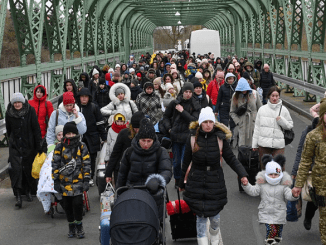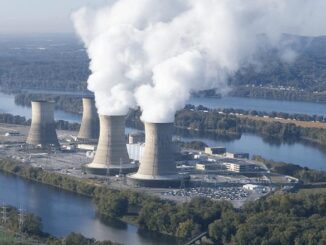
VIENNA, Austria, March 6, 2022 (ENS) – Ukraine informed the International Atomic Energy Agency today that although regular staff continues to operate the Zaporizhzhya Nuclear Power Plant, the plant management is now under orders from the commander of the Russian forces that took control of the site last week, IAEA Director General Rafael Mariano Grossi said.
Ukraine reports that any action of plant management, including measures related to the technical operation of the six reactor units, requires prior approval by the Russian commander.
Director General Grossi expressed grave concern about this development as it contravenes one of the seven indispensable pillars of nuclear safety and security that he outlined at the meeting of the IAEA’s Board of Governors on March 2, convened to address the safety, security and safeguards implications of the situation in Ukraine.
Pillar 3 states: “The operating staff must be able to fulfil their safety and security duties and have the capacity to make decisions free of undue pressure.”
Located in southeastern Ukraine, the Zaporizhzhya Nuclear Power Plant is the largest nuclear power plant in Europe and among the 10 largest in the world. It was built by the Soviet Union near the city of Enerhodar, on the southern shore of the Kakhovka Reservoir on the Dnieper River.
The plant generates nearly half of the country’s electricity derived from nuclear power, and more than a fifth of total electricity generated in Ukraine.
In a second serious development, Ukraine has reported that the Russian forces at the site have switched off some mobile networks and the internet so that reliable information from the site cannot be obtained through the normal channels of communication.
This has been confirmed by Ukraine’s nuclear regulator, which informed the IAEA today that it had started having major problems in communicating with staff operating the Zaporizhzhya Nuclear Power Plant. Less than 24 hours after Ukraine’s regulatory authority said it had been able to maintain communications with Ukraine’s largest nuclear power plant, it today said the phone lines, as well as e-mails and fax, were not functioning anymore. Mobile phone communication was still possible, but with poor quality.
The contravenes another of the seven indispensable pillars, “There must be reliable communications with the regulator and others.”
“I’m extremely concerned about these developments that were reported to me today,” Director General Grossi said. “Just a few days after I presented the seven main elements of nuclear safety and security to the IAEA Board, several of them are already being compromised. In order to be able to operate the plant safely and securely, management and staff must be allowed to carry out their vital duties in stable conditions without undue external interference or pressure.”
“The deteriorating situation regarding vital communications between the regulator and the Zaporizhzhya Nuclear Power Plant is also a source of deep concern, especially during an armed conflict that may jeopardize the country’s nuclear facilities at any time. Reliable communications between the regulator and the operator are a critical part of overall nuclear safety and security,” he said.
Despite the communication issues, the regulator was able to provide updated information about the operational status of the Zaporizhzhya Nuclear Power Plant and to confirm that radiation levels there remained normal.
Only two of the six reactors are operating currently. Unit 1 is in planned maintenance until mid-2022, Unit 2 now operates at full capacity, Unit 3 is in a cold shutdown state, Unit 4 is operating at near full capacity, Unit 5 is cooling down for a cold reserve state, and Unit 6 is in cold shutdown, the IAEA said.
In one positive development, operational teams at the plant are now rotating in three shifts. But there are problems with availability and supply of food, which is having a negative impact on staff morale, the regulator said.
On March 3, artillery strikes by Russian forces damaged some buildings at the plant. A fire occurred near reactor Unit 1, but essential equipment was not damaged. A US Energy official stated that the reactor was being safely shut down. After an intense battle, Russian troops captured the power plant after confirming that there were no changes to radiation levels.
The fire, which was in a training building, was extinguished before it impacted reactor safety or any essential equipment. The plant lost 1.3 GW of capacity which then was compensated by additional nine power units in the thermal power station nearby.
The regulator also reported that it was facing problems communicating with personnel at the Chernobyl Nuclear Power Plant, which at the moment is only possible with e-mails. Russian forces took control of the site of the 1986 accident on February 24. At the Chernobyl Nuclear Power Plant, the staff of more than 200 technical personnel and guards have still not been able to rotate since February 23.
Director General Grossi has repeatedly stressed the importance of operating staff being able to rest to carry out their important jobs safely and securely.
In another concerning development, communications have also been lost with all enterprises and institutions in the port city of Mariupol that use Category 1-3 radiation sources and there is no information about their status, the regulator said. Such radioactive material can cause serious harm to people if not secured and managed properly.
Featured image: Zaporizhzhia Nuclear Power Plant, the biggest nuclear power station in Europe, consisting of two cooling towers at the left and 6 VVER reactor buildings. July 10, 2009 (Photo by Ralf1969)



